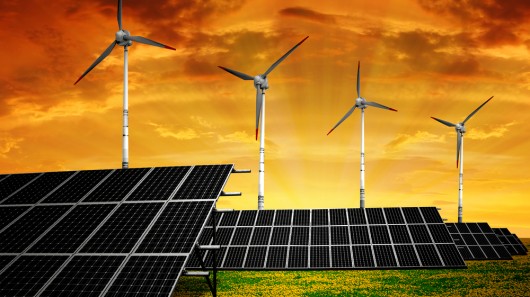
A new study claims that a municipal grid could be powered almost entirely via renewable sources (Image: Shutterstock)
Although critics of renewable energy may claim that it isn't reliable enough to power a grid, a new study gives proponents of clean power – such as wind and solar – fresh ammunition to respond. A thorough analysis carried out by the University of Delaware and Delaware Technical Community College concluded that renewable energy could reliably power a large electrical grid 99.9 per cent of the time by 2030, at a cost that matches today’s electricity prices.
A diversified energy mix, an expanded geographic area of renewable generation, and efficient storage media such as batteries and fuel cells are key to running a successful renewable-powered grid. With that in mind, the study utilized a computer model that looked at 28 billion combinations of renewable energy sources and storage devices. It was found that a 72 GW electric system, for instance, could be run 99.9 percent of the time with a hydrogen storage system using 17 GW of solar, 68 GW of offshore wind, and 115 GW of inland wind.
Fossil fuel would be used in the event that renewable energy sources and stored power aren't able to meet demand. When supply outstripped demand, the model prioritized storing the excess power before using the remaining energy to replace natural gas for heating homes and businesses. If there was any excess left after that, only then it would go to waste.
The research spanned four years based on weather and energy demand data drawn from PJM Interconnection, a regional grid linking 13 states including New Jersey and Illinois. PJM makes up one-fifth of America’s total electrical grid.
In order to address the projected costs of clean energy, the study focused on minimizing costs instead of matching generation to electricity use, like similar studies have done. The authors used both current costs and 2030 costs, the latter of which they estimated would be about 50 percent lower than the former – they didn't assume new technologies would be developed, but did assume lower costs due to increasing production and technical experience. Maintenance costs were projected to remain the same.
The study also assumed costs without government subsidies, and compared them to the cost of generation of the most commonly-used types of fossil fuel, factoring in external costs such as the effects of power plant air pollution on human health.
The study makes a clear case for renewable energy (on which Germany is already sold) as a way to meet 80 to 90 per cent emission targets, which could be achieved if we aim for 90 percent or more renewable energy in 2030. Besides making environmental sense, it also makes economic sense, the authors say.
The research appeared online last month in the Journal of Power Sources.
Source: University of Delaware
About the Author
Copyright © gizmag 2003 - 2012 To subscribe or visit go to: http://www.gizmag.com
 Brazilian-Italian Antonio Pasolini graduated in journalism in
Brazil before heading out to London for an MA in film and
television studies. He fell in love with the city and spent 13
years there as a film reviewer before settling back in Brazil.
Antonio's passion for green issues - and the outdoors -
eventually got the best of him and since 2007 he's been writing
about alternative energy, sustainability and new technology.
Brazilian-Italian Antonio Pasolini graduated in journalism in
Brazil before heading out to London for an MA in film and
television studies. He fell in love with the city and spent 13
years there as a film reviewer before settling back in Brazil.
Antonio's passion for green issues - and the outdoors -
eventually got the best of him and since 2007 he's been writing
about alternative energy, sustainability and new technology.